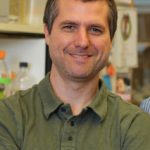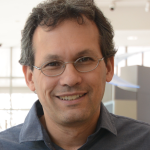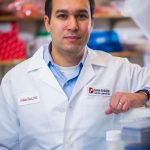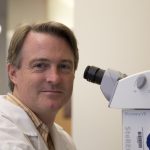Patients with leukemia require new and better medicines. While current drug treatments can often clear most leukemia cells from the body, too often the disease will become resistant. We believe that it is important to find new drugs that target the parts of cancer cells that control how and when specific cancer genes are turned on or off. These systems work at regions of our genome called ‘enhancers’. Enhancers represent the most important circuits of our genome by coordinating what genes are on or off. In cancers like leukemia these circuits are broken. This leads to an altered state of unrestrained growth, survival under stress, and resistance to drugs. In leukemia cells there are many mutations in genes that change how enhancers work, but few drugs to target them. We need a complete toolbox of enhancer-targeting drugs and we are making significant progress – but more work is needed to understand how these drugs work in order to identify the patients most likely to benefit. Our goals with this project are to use new genomics tools to study the effects of a new class of enhancer-targeting drugs that directly block critical signaling factors. These drugs have not yet been studied in leukemia, and we expect that our efforts will lead to future use of this promising new type of medicine.
State: Massachusetts
Christian Dibble, Ph.D.
Funded by the Stuart Scott Memorial Cancer Research Fund
Normally, the cells of our body grow and divide only when needed. In cancer, however, this organization breaks down and cells grow out of control. Our lab studies signaling pathways that act as the cell’s circuitry and control when it grows and divides. We also study cellular metabolism, which consists of the chemical reactions a cell uses to turn nutrients into energy and cellular building blocks. Growth signaling pathways are often what become mutated and abnormally activated in cancer, in part, because they play important roles in controlling metabolism. We are particularly interested in a critical metabolic cofactor known as Coenzyme A, which is required to produce cellular energy and building blocks. We have gathered evidence that some cancer cells may have a greater need for Coenzyme A compared to normal cells. Therefore, it may be possible to kill certain tumors before damaging normal tissues by targeting Coenzyme A metabolism. We will characterize specific mutations that may make cells vulnerable to this treatment, and test this treatment concept in cancer cell cultures and mouse tumors. Our basic research into whether this treatment has promise is the necessary first step towards developing a potential new drug that may one day be used to successfully treat patients.
Nir Hacohen, PhD
Funded by the Scott Hamilton CARES Foundation
Most cancer treatments — such as chemotherapy, radiation therapy and targeted therapy — work by direct killing of cancer cells. Some of the recent and most powerful therapies work by stimulating the patient’s own immune system to kill cancer cells. While these new immune-based therapies work better than most previous therapies and are now approved for treating 13 cancer types, they do not work for all patients. To understand why these treatments works for some patients and not others, we need better tools to investigate how the immune system interacts with cancer. We have developed a new way of growing tumors outside patients’ bodies to study how tumor cells and immune cells interact with each other. Our goal is to study how different types of immune cells stop cancer growth. We use our new method for growing tumors outside of the body to test out new treatments designed to steer the immune response towards tumor cells more effectively. If initial tests are successful, we will aim to try these new treatments in patients with melanoma and potentially other types of cancer.
Adam Bass, M.D.
Stomach cancer, the third-leading cause of cancer death world-wide, is classically divided into two primary types, one of which is called Diffuse Stomach Cancer (DSC). DSC is a very aggressive and rapidly-lethal disease where we lack effective therapies. Additionally, DSC also impacts a relatively unique group of patients. DSC is increasingly common in young females, often women in their 30’s-40’s and is also highly prevalent in the Latin American and Native American populations. Unfortunately, although DSC patients are in tremendous need of therapies, there has been relatively little laboratory research seeking to understand biology of these cancers or to develop new, more effective therapies. At our cancer center, we have established a new collaborative research program aiming to address this critical unmet medical need. We have built off of the progress we have made by studying the specific genes that are abnormally turned on in these cancers. Over the past years we have specifically studied the biology of DSC and have defined new highly promising candidate therapeutic approaches. Additionally, our collaborative team has developed new cancer models (cancer cells we can grow and study in the laboratory) from Latin American patients’ (and young females’) cancers. We now propose to bring together our new candidate therapies and this new collection of patient models to prepare optimal therapeutic approaches for DSC into clinical trials. This work will enable us to rapidly bring the most promising new therapeutic approaches into patients, including under-represented minorities whose cancers are often not adequately studied.
Pratiti Bandopadhayay, M.D., Ph.D.
Funded by the Dick Vitale Pediatric Cancer Research Fund
Diffuse Intrinsic Pontine Gliomas (DIPGs) are heartbreakingly aggressive tumors of childhood for which no curative treatments currently exist. Our research is focusing on a gene called PPM1D which is commonly mutated in DIPGs. We are studying how these mutations cause the tumors to grow and are trying to find ways in which we can target them in new treatments for children with DIPG.
Leonard Zon, M.D.
Funded in partnership with Adenoid Cystic Carcinoma Research Foundation (ACCRF)
We recently found that retinoic acid treatment reduces the growth of a salivary gland tumor. The retinoic acid has the ability to shut down the cause of the cancer which is due to the overactivity of a gene called c-myb. Retinoic Acid has been successfully given to patients with a rare type of leukemia and we plan to use the same doses as the leukemia patients. We will examine whether the retinoic acid is active in the tumor and whether the growth of the tumor is reduced. Our studies have the possibility of finding the first treatment for this metastatic tumor.
Ann Partridge, M.D.
Supported by Bristol-Myers Squibb through the Robin Roberts Cancer Thrivership Fund
People who have been treated for cancer are not only at risk of cancer returning, but also at risk of long term side effects of their treatments some of which may threaten their life, including heart disease and other cancers. Medical teams are always searching for new ways to identify and reduce these risks. Some people will develop changes in their blood cells called “Clonal Hematopoiesis” (CH) and people with these changes have recently been found to be at higher risk of developing serious problems such as cancer and heart attacks and dying. CH is found more in older than younger people and more commonly in people who have been treated for cancer. We don’t know how common CH is in cancer survivors, who is at risk, when it develops and when and if we should be looking for it. But we are finding it more commonly with genetic tests that are being done as a part of their care. Our team hopes to provide answers to these questions by looking for CH in a group of women who were treated for breast cancer at a young age and agreed to give us blood samples and let us follow them over time. We will do special testing to find CH in their stored blood and see how it is different in different women, and changes over time. We will also ask them how they might feel about learning about CH results if they had CH, how learning about these risks that might affect them, and what they might need to support them best to help them to manage these risks. We hope this research leads to findings that can be used to understand this problem better and to improve how we take care of cancer survivors both now and in the future.
Jens Lohr, M.D., Ph.D.
Multiple Myeloma is a cancer of the bone marrow that cannot be cured. Patients typically receive many different therapies that work initially but some myeloma cells always remain, eventually leading to relapse. This is due to enormous genetic diversity of myeloma in each patient that also changes with every treatment, ultimately leading to outgrowth of drug-resistant myeloma cells. It is therefore crucial to understand why myeloma cells persist despite drug treatment and define the genomics and molecular mechanisms of drug resistance. To do so would require frequent access to myeloma cells from bone marrow biopsies. However, the current standard of care, a bone marrow biopsy from a single site at time of diagnosis, is not sufficient to capture the diversity and constant evolution of myeloma. We are proposing to use novel “liquid biopsy” approaches we developed to replace bone marrow biopsy using circulating multiple myeloma cells and cell-free myeloma DNA that we obtain from a simple blood draw. Our hypothesis is that liquid biopsy will allow us to obtain more comprehensive genomic characterization of myeloma than bone marrow biopsy, with less risk and discomfort for patients. With the use of novel technology we can also obtain comprehensive genomic and molecular information from very few cells when patients are in remission and no myeloma is detectable with conventional methods. We can use this technology to test if genomic events that cause drug resistance predict relapse. These approaches may replace bone marrow biopsy and identify molecular mechanisms that drive resistance to therapy.
R. Coleman Lindsley, M.D., Ph.D.
Cancers develop changes in their genes, as well as changes in parts of the cell that control genes. BCOR is a gene that regulates cells by controlling genes, and is changed in a wide range of cancers affecting the blood and organs. By studying a group of more than 20,000 patients with cancer, we saw that the type of BCOR mutation found in a cancer depends on the tissue in which the cancer arises, suggesting that BCOR may have a range of different roles. In patients with endometrial cancer, BCOR mutations are common, and affect a specific part of the gene. The first goal of our study is to describe the clinical impact of BCOR mutations in a large group of patients with endometrial carcinoma. The second goal is to understand how BCOR mutations affect the function and contribute to cancer in cells from different tissues.
Frank Slack, Ph.D.
Diffuse Large B-cell lymphoma (DLBCL) is a common cancer in the US, causing tens of thousands of deaths each year and their incidence is on the rise. MicroRNA regulate the use of other genes and they are frequently mutated in human cancer One of these, miR-155 has been shown to be overproduced in several different lymphoma types, including cutaneous T-cell lymphoma (CTCL) and diffuse large B-cell lymphoma (DLBCL). This miRNA is an excellent target for therapy in DLBCL. miRagen Therapeutics, Inc. is currently testing the safety and efficacy of an inhibitor to miR-155 in patients with CTCL and DLBCL. This is an entirely novel class of drug, and as such requires some research into the parameters for successful delivery and monitoring. In this proposal we seek funding to allow studies that would support these clinical trials. We propose to identify biomarkers to help stratify patients to enroll in the clinical trial, biomarkers of response, and to determine the best route of delivery and the best source of tissue for miR-155 detection.













